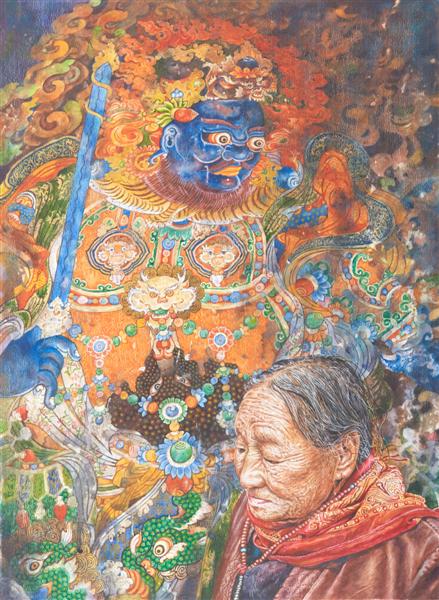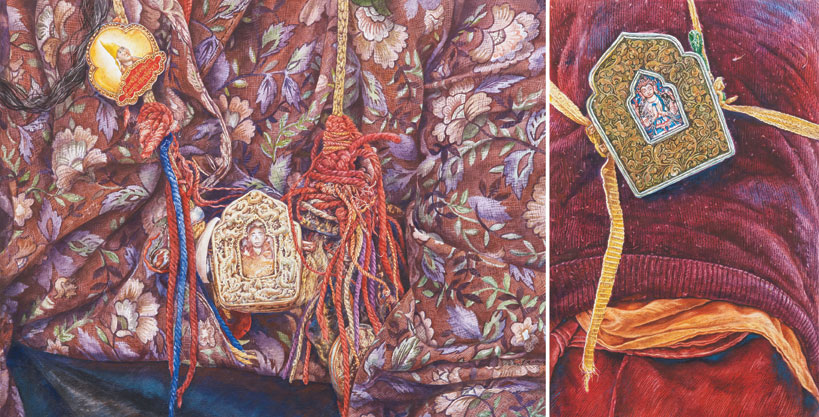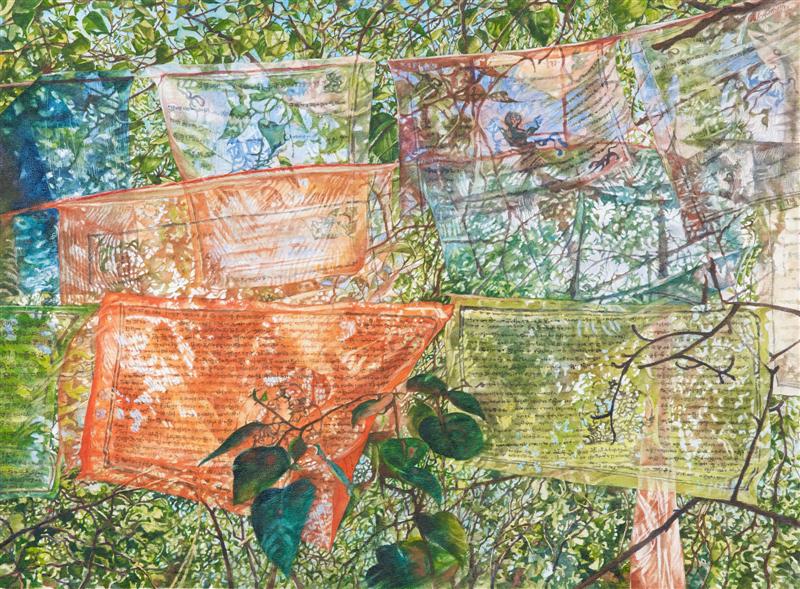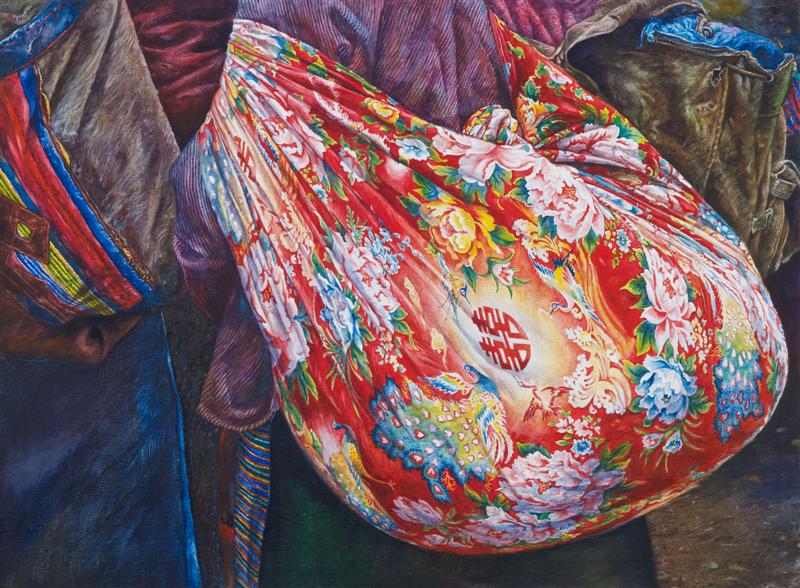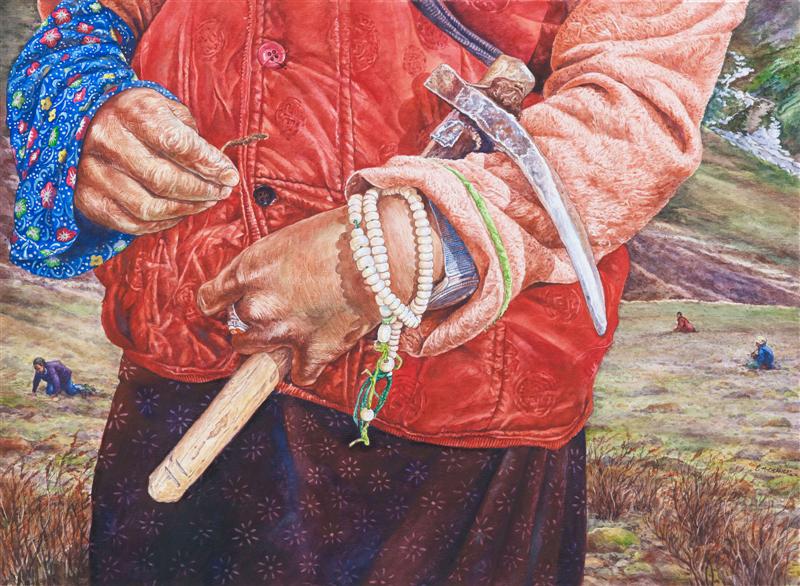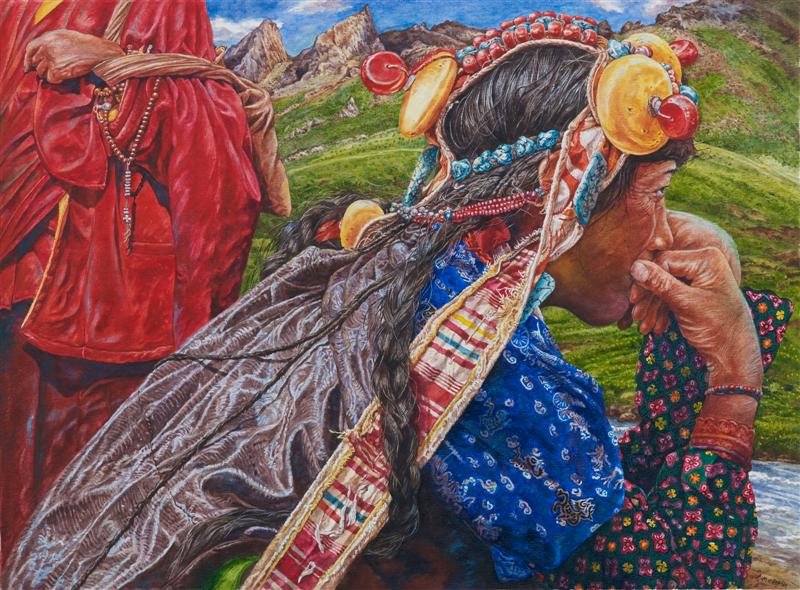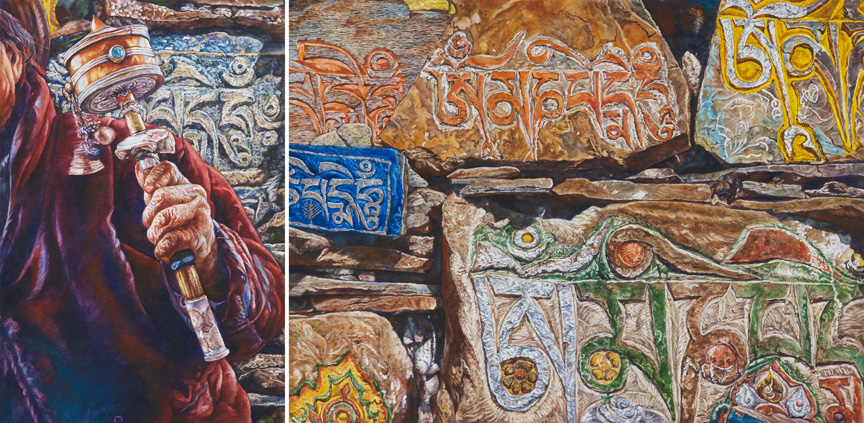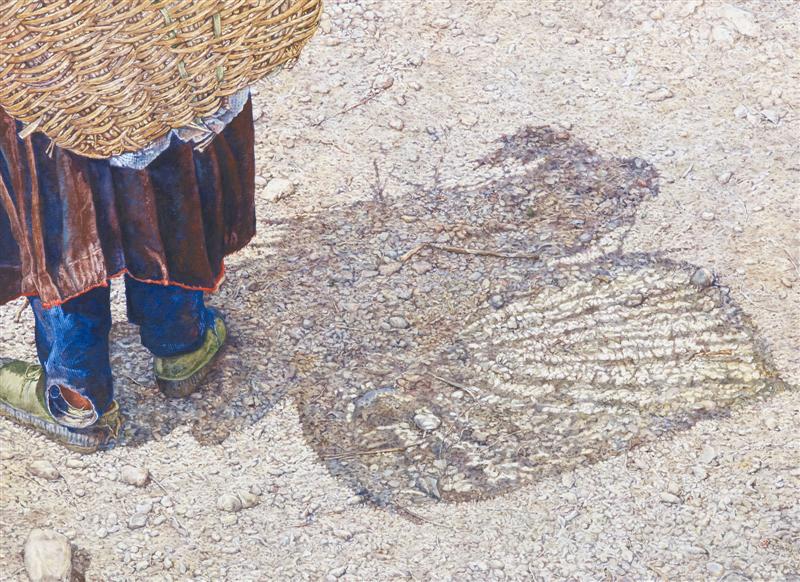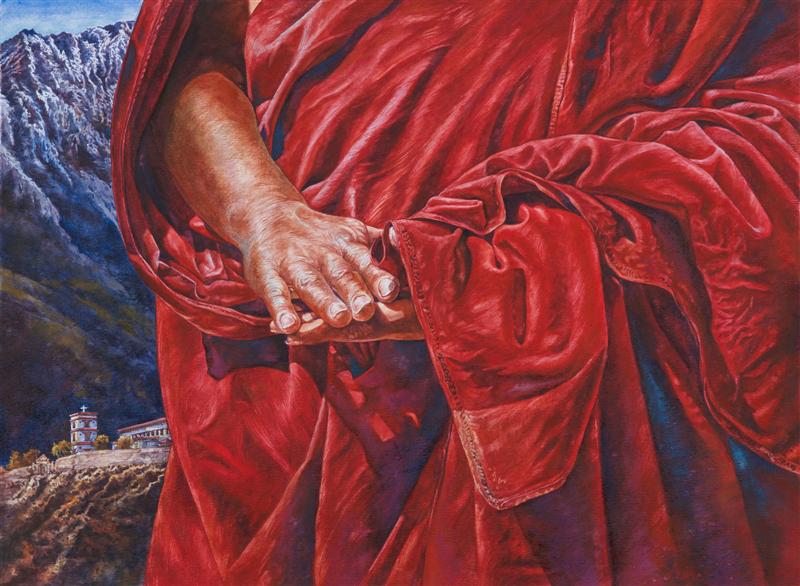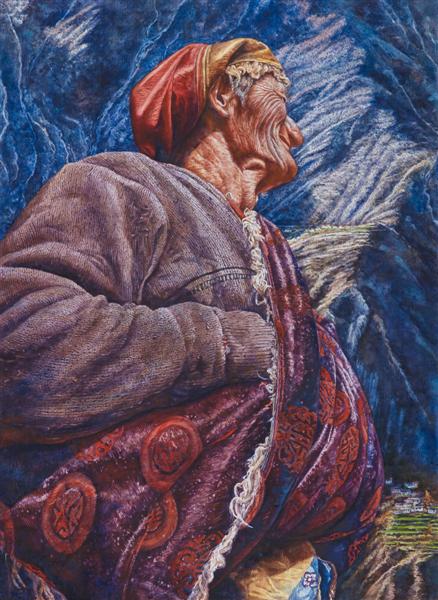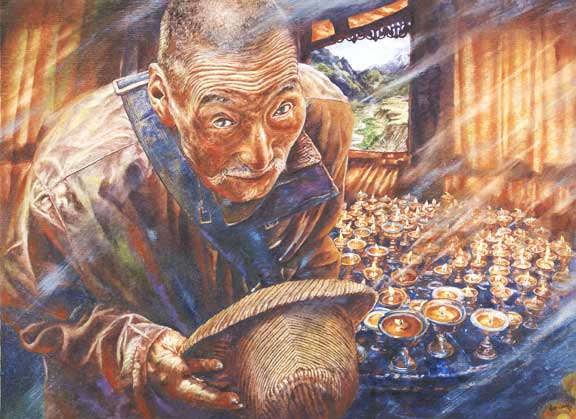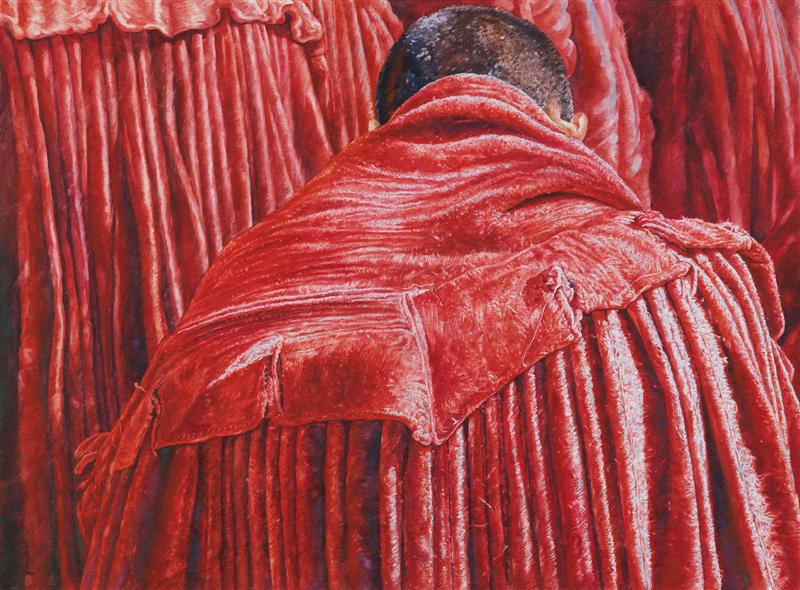Chang Fee Ming
Mekong: Exploring the Source
Many are familiar with Chang Fee Ming’s earlier work, capturing kampong life in his home state of Terengganu, or the colour and ceremony of Bali, even the splendour of Mandalay’s Buddhist culture. In 2004, he exhibited the first body of his Mekong series, taking his audience into more unfamiliar and difficult territory. The Mekong series is not only an invaluable document of communities whose survival may be threatened by the forces of change and development.
Four years on from his landmark Mekong exhibition, Chang Fee Ming unveils the sequel, a remarkable series of sixteen major watercolours and accompanying portraits, sketches and studies made from his travels to the Tibetan region around the source of the great river. This current body of work explores the narratives embedded in the life and landscape of this beautiful but troubled area. Mekong: Exploring the Source begins at VWFA KL in March and travels on to Vanessa Art Link at 798 in Beijing in May and to Singapore in July.
About the artist
Born in Kuala Terengganu, Malaysia in 1959, Chang Fee Ming is a self-taught artist who began his career in the early 1980’s. Since winning the Malaysian Watercolour Society Award in 1984, he has gone on to gain many accolades both locally and internationally, and became a Signature Member of The National Watercolour Society (USA) in 1994. He has exhibited widely in the Southeast Asian region, with solo shows in Kuala Lumpur, Jakarta, and Bali, and participated in numerous major exhibitions in Malaysia, Australia, Taiwan, South Korea, Thailand, China, Indonesia, USA, Canada, Hong Kong, UK, Sweden and Brazil. His works have also appeared at auction at Christie’s and Sotheby’s over the past seven years.
In 1995, he published “The World of Chang Fee Ming” (Ooi Kok Chuen & Garret Kam) and in 2000 published “The Visible Trail of Chang Fee Ming” (Christine Rohani Longuet). He is currently based in Kuala Terengganu, spending much of his time traveling through Asia.
Since his beginnings as a self-taught artist, Chang Fee Ming has gone on to engender a whole new approach to the medium. His craftsmanship is unparalleled, yet importantly his is a continual exploration of the possibilities of watercolour to capture the light and temperature, the drama and detail of Southeast Asian life. He is also a consummate narrator, and so his work does not merely document and celebrate, it is also sensitive to the poignancy and the painful ironies of an older Southeast Asian world in transition, and above all testifies to the resilience of the human spirit and of cultural tradition in the face of change.
An Introduction
Mekong – Exploring the Source began as the continuation of an earlier journey. It is a sequel to Chang Fee Ming’s 2004 exhibition Mekong, a culmination of seven years of research and travel along Southeast Asia’s greatest river, from its upper reaches in Weixi, Dali, and Xishuangbanna in Yunnan, China down to Cuu Long, or “Nine Dragons” delta in Vietnam. Mekong, consisting of over thirty major works and a large body of drawings and studies, took us through parts of China, Thailand, Myanmar, Laos, Cambodia and Vietnam in a rich and complex investigation of life, culture and change in this key region of Southeast Asia. The exhibition was inaugurated in Kuala Lumpur, and traveled on to Jakarta and then Chiangmai in the Mekong region.
Having reached the northern limits of what might be considered a Mekong cultural region, Fee Ming determined that he would push on upwards, compelled to find the source of the river. In 2005 he made his first trip to reach the source, beginning at Zhongdian in Yunnan, traveling through Tibet to Yishun in Qinghai, but was cut off from his final destination by territorial fighting over access to the valuable dongchongchao caterpillar fungus. In 2006 he finally succeeded, traveling through Qinghai from Xining to Yishun and on to Zadoi, the nearest town to the source.
This new series then, begins very far up the river Mekong, where it is called Dzachu – “river of rocks”. It covers the Tibetan region around the source, from Qinghai through Tibet to north Yunnan. The exhibition, like Mekong, originates in Kuala Lumpur, and then travels back up to Beijing, and on to Singapore.
Mekong was for Chang Fee Ming anchored in a search for home, for a sense of belonging to the Southeast Asian region. Like other regionalists before him, he traveled the Mekong to find cultural roots stretching back to its early kingdoms, architecture, aesthetics, its tribal communities; to find resonances with beliefs, ways of life, difficulties not so far away from his own. The journey to the source was a natural progression, a further tracing back. The tribes encountered in Thailand and Myanmar surely had their ancestry on the plains of Tibet, and Fee Ming has always been interested in the migration of tribes and their cultures, driven out by stronger races or harsh conditions in the north, their lives and context changing as they relocate downstream.
The Tibetan region around the source of the Mekong, however, is very far from home for the artist, who was born on the northeast coast of Malaysia, of the sea rather than of the mountain. He found life there to be very much unlike life downstream, where despite challenges, there are nonetheless resources and opportunities to be had. The harsh, unforgiving conditions of Tibetan life afford no weakness. Its ritual traditions, with both Buddhist and animist elements, maintain a spiritual strength and also a strong link to nature, whose mercy it is beholden to.
Chang Fee Ming’s is driven by his sympathy for independent communities with a strong sense of heritage and tradition, whether in Terengganu, Bali, Mandalay, or the Swahili Coast. The Tibetan plains may seem very far from the gentle, sensuous world of the archipelago, but this new series of paintings may be the artist’s strongest statement yet about cultural survival and human resilience.
The narrative strain of Mekong continues to prevail in this exhibition, but where Mekong encompassed many stories of different communities and cultures, here the artist has pieced together a unified picture of Tibetan life as he has witnessed it. Each painting focuses on key themes of Tibetan experience – forms and physical elements of prayer, seasonal migration, the harvesting of precious herbs, the Buddhist monk, the mountaineer, the gathering of women at market. Man, woman, child and beast are firmly placed in the landscape, heretofore seldom seen in Fee Ming’s work. There are stories of love, separation, pilgrimage, travel, work, persistence. Fee Ming also takes pains to express the textures of his experience – the solidity of rock, painted and carved with mantras, the gossamer lightness of worn prayer flags, the woolen thickness and fine detail of warm clothing.
Upstream from the river in Southeast Asia, here on the plains, the air changes, becomes rarefied and thin; the light changes, intensifying. Colours become extreme at this high altitude. In several paintings, Fee Ming reveals a searing, almost painfully blue sky. Everything is cold and dry, a far cry from the humid warmth, the warm colours nearer to home. The mountain landscape looms in chiarascuro. Festive dress is richly coloured, as is ritual ornament. There are brave contrasts, and a sense of brightness battling the cold.
The new subject with its new light, temperature and textures, has posed exciting challenges for Fee Ming as a watercolourist. He has met them with bravura, exercising his different technical strengths and developing new approaches in each of the works. To accentuate the effect of bright sunlight on surfaces, he makes extensive use of paper white, also taking a hard clean brush to “etch” out details, creating flecked textures on woolen clothing, horse’s fur. To bring out and enliven the dark crevices of the mountains, the deep folds of thick cloth, he applies repeated layers of light colours such as emerald and turquoise over the dark. Broad washes using a thick oil brush on selected areas create different grades of sharpness, deepening perspective, as with a camera lens. Professor Guo Jing refers to the result as a “melody of light and shadow”; a certain unified strain runs through the series, cold, bright, serene.
Just as the contrast between light and shadow defines the tone of this series, its “stories” are often defined by the relationship between two elements – the symmetry between man or woman and their environment, the contrast between a bright new factory-made modern fabric, and the well-worn textures of traditional clothing, the dialogue between a Catholic missionary past and a long tradition of Buddhism that lives on, the imminent separation of a man and a woman.
Christine Rohani Longuet in her essay makes several references to how some of the compositional constructs of this new series echo particular paintings of the previous Mekong series. Over time, we have seen Fee Ming consistently draw parallels or mark differences between cultural practices and material in this way. Familiar themes of youth and age, the past and the future, the role of religion and ritual, are translated to a new context. While in Mekong, some strong political and social statements are made through such themes, here Fee Ming attempts a more holistic approach to a people and their culture. The practice of Buddhism, of course, is different in its form and ritual, from its practice downstream in Southeast Asia. People face similar challenges of change and development, but at the same time also have to endure real physical hardship.
Any foray into the Tibetan region brings with it the hanging issues of nationalism and sovereignty. While Fee Ming does not presume to express an overtly political stance, his work shows a real passion for a community’s will to preserve their traditional culture and life. He has found in his subject a stoicism and toughness he obviously admires; a people who have achieved a sense of one-ness with an overpowering natural environment, through sheer physical strength and a deep spiritualism which pays tribute both to Buddhism and to the gods of mountain, sky and earth, and who have chosen a hard path to maintain their way of living. This exhibition tells a powerful, personal story of Tibetan lives, one of choice, humanity, and faith.
Beverly Yong, Curator
Kuala Lumpur 2008

